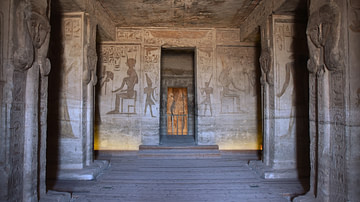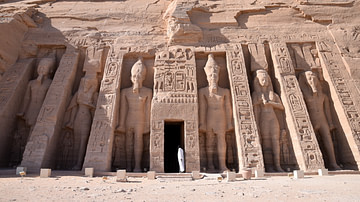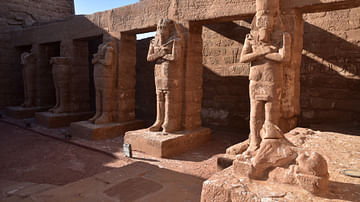Search
Did you mean: Ramesses II?
Search Results

Definition
Palestine
Palestine in the ancient world was part of the region known as Canaan where the Kingdoms of Israel and Judah were located. The term `Palestine' was originally a designation of an area of land in southern Canaan which the people known as the...

Definition
Moses
Moses (c. 1400 BCE) is considered one of the most important religious leaders in world history. He is claimed by the religions of Judaism, Christianity, Islam and Bahai as an important prophet of God and the founder of monotheistic belief...

Definition
Ancient Egyptian Vizier
The vizier in ancient Egypt was the most powerful position after that of king. Known as the djat, tjat, or tjati in ancient Egyptian, a vizier was the equivalent of the modern-day prime minister of the nation who actually saw to the day-to-day...

Image
Abu Simbel, Interior of the Temple of Hathor
The Temple of Hathor or "Small Temple" was constructed during the reign of Ramesses II (c. 1279 - c. 1213 BCE). It was dedicated to the goddess Hathor and Queen Nefertari, Ramesses' favourite wife. The temple's hypostyle hall is supported...

Image
Abu Simbel Panorama
Abu Simbel is a temple complex, originally cut into a solid rock cliff in southern Egypt at the second cataract of the Nile River. The two temples that comprise the site (The Great Temple and The Small Temple) were created during the reign...

Image
Abu Simbel, Facade of the Temple of Hathor
The Temple of Hathor or "Small Temple" was constructed during the reign of Ramesses II (c. 1279 - c. 1213 BCE). The Small Temple was dedicated to the goddess Hathor and Queen Nefertari, Ramesses' favourite wife. On the facade, six colossi...

Image
Forecourt of Wadi es-Sebua Temple, Egypt
The peristyle court of the temple of Wadi es-Sebua, filled with reliefs displaying processions of Ramesses II's sons and daughters on both walls and pillars with figures of Ramesses himself with both arms crossed and wearing a shendyt. Approached...

Article
Clergy, Priests & Priestesses in Ancient Egypt
The ancient Egyptians understood that their gods had prevailed over the forces of chaos through the creation of the world and relied upon humanity's help to maintain it. The people of Mesopotamia held this same belief but felt they were co-workers...

Article
Games, Sports & Recreation in Ancient Egypt
Although the ancient Egyptians are often depicted as death-obsessed and dour, they actually had a great appreciation for life and their culture reflected their belief in existence as an eternal journey imbued with magic. Life was a gift from...

Video
Introduction to the Ancient Egyptian Pharaoh
Some of the most famous ancient Egyptian pharaohs including Ramesses II, also known as Ramesses the Great, come from the New Kingdom period of Egypt during the eighteenth and nineteenth dynasties. It was during this time that the title pharaoh...